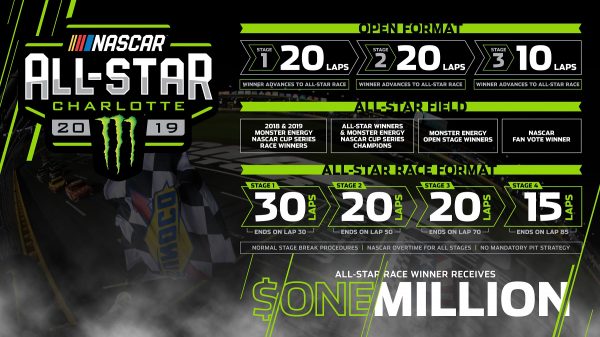
NASCAR will once again use its annual All-Star Race to give fans, and competitors, a glimpse into the future.
The sanctioning body and Charlotte Motor Speedway revealed the technical specifications along with the format for next month’s race on Wednesday.
Chief among the technical specifications will be several that are being tested as part of NASCAR’s next generation racecar known as Gen-7. The driver’s will once again race for a $1 million payday, while they and their teams get a real-world experience with technical components that could be implemented in the next generation car.
“Throughout its history, the Monster Energy NASCAR All-Star Race has provided a platform to try new and innovative ideas, some of which we have incorporated on a full-time basis,” said Steve O’Donnell, NASCAR executive vice president and chief racing development officer. “Last year’s all-star rules package resulted in one of the most exciting all-star races in history. With a similar package, and added elements that we could see in the next generation race car, we expect another must-watch event.”
NASCAR implemented rule changes in last year’s All-Star Race designed to tighten competition. Some were carried over to the current packed being raced.
The race will again have four stages, with a five lap increase in the final stage compared to last year’s race. The stages will last 30 laps, 20 laps, 20 laps and 15 laps. Both green flag and yellow flag laps will count in Stages 1-3; with only green flag laps counting in the Final Stage. NASCAR Overtime rules will be in effect for Stages 1-3. In the final stage, if the race is restarted with two or less laps remaining, there will be unlimited attempts at a green, white, checkered finish under green flag conditions.
For the 2019 edition, the race cars will feature two keys technical elements that NASCAR may incorporate into the Gen-7 car slated to debut in 2021.
The first is single-piece carbon fiber splitter/pan that should offer dramatic improvements in ride height sensitivity for the drivers. This technical component will provide a more stable aero platform and create more consistent performance in traffic. Also, the car will be configured with a radiator duct which exits through the hood as opposed to the current design which exits into the engine compartment. This feature will create improved aerodynamic parity and, at the same time, reduce engine temperatures.
The Monster Energy Open will occur Saturday evening prior to the Monster Energy All-Star Race and will include three segments (20 laps / 20 Laps / 10 laps). The winner of each segment will earn a spot in the All-Star Race.
Those eligible for the Monster Energy All-Star Race include: drivers who won a points event in either 2018 or 2019; drivers who won a Monster Energy All-Star Race and compete full-time; and drivers who won a Monster Energy NASCAR Cup Series championship and compete fulltime. Those who have not already earned a spot via the above criteria can still lock-in by winning a stage in the Monster Energy Open or by winning the Fan Vote. Polls for the fan vote are open now on NASCAR.com.
Drivers who have already clinch an All-Star Race spot: Aric Almirola, Ryan Blaney, Clint Bowyer, Kurt Busch, Kyle Busch, Austin Dillon, Chase Elliott, Denny Hamlin, Kevin Harvick, Jimmie Johnson, Erik Jones, Brad Keselowski, Joey Logano, Ryan Newman and Martin Truex Jr.
Coverage of the Monster Energy NASCAR All-Star Race will begin on May 18 at 5 p.m. ET on FS1. The Monster Energy Open will air at 6 p.m. and the Monster Energy NASCAR All-Star Race begins at 8 p.m. on FS1, MRN and SiriusXM NASCAR Radio.
- Spire Motorsports confirms split with Corey LaJoie - July 25, 2024
- Kyle Larson wins NASCAR Brickyard 400 after overtime chaos - July 21, 2024
- Photos: NASCAR at the Brickyard Sunday July 21, 2024 - July 21, 2024
